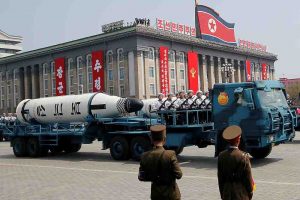
Military vehicles carry missiles with characters reading ‘Pukkuksong’ during a military parade in Pyongyang, North Korea, April 15, 2017.
SEOUL: Eight months into a strict, coronavirus-triggered border shutdown, nuclear-armed North Korea is widely expected to stage an attention-grabbing display of its latest and most advanced weaponry at a mass military parade in Pyongyang on Saturday.
The cavalcade will mark the 75th anniversary of the ruling Workers’ Party and satellite imagery on the respected 38North website suggests it could be huge.
“It’s very clear they are preparing for a big one,” Vincent Brooks, former commander of US Forces Korea (USFK), told an Atlantic Council conference.
Thousands of goose-stepping soldiers will march through Kim Il-sung Square, named for North Korea’s founder, under the gaze of his grandson Kim Jong Un, the third member of the family to rule the country.
A procession of progressively larger armoured vehicles and tanks will follow, culminating with whatever missiles Pyongyang wants to put on show.
That will depend on the message it wants to send.
As tensions mounted in April 2017 giant canisters big enough to hold intercontinental ballistic missiles — which North Korea had yet to test at the time — rumbled through the square, sending shockwaves through the analyst community.
But in September 2018, with diplomatic processes in full swing among Pyongyang, Washington and Seoul, the ICBMs were conspicuous by their absence — a reticence welcomed by US President Donald Trump.
Relations now are more fraught.
Nuclear negotiations between Pyongyang and Washington have been deadlocked since the collapse of the Hanoi summit in February last year.
North Korea is widely believed to have continued to develop its arsenal — which it says it needs to protect itself from a US invasion — throughout the discussions.
At the end of December, Kim threatened to demonstrate a “new strategic weapon.” Analysts anticipate a new submarine-launched ballistic missile (SLBM) or an ICBM capable of striking the US mainland to be put on show — maybe even one with multiple re-entry vehicle capabilities — but say North Korea will tread carefully to avoid jeopardising its chances with Washington.
And despite speculation of a potential “October Surprise” ahead of the US election on November 3, they say an actual missile launch is unlikely.
“Showing it in the parade rather than testing it would be a nonprovocative way of showcasing it,” said Jenny Town, a fellow at the Stimson Center.
‘Masks and missiles’
Saturday’s anniversary comes during a difficult year for North Korea as the coronavirus pandemic and recent storms add pressure to the heavily sanctioned country.
The impoverished nation — whose crumbling health system would struggle to cope with a major virus outbreak — has not confirmed a single case of the disease that has swept the world since first emerging in China, North Korea’s key ally.
Pyongyang closed its border with China in January to try to prevent contamination, which USFK Commander Robert Abrams said effectively “accelerated the effects” of economic sanctions imposed on North Korea.
And last week Pyongyang’s troops shot dead a South Korean citizen who had drifted into its waters, apparently as a coronavirus precaution, causing outrage in the South.
The incident sparked a rare apology from Kim himself.
The parade will aim to send the domestic audience a message that “despite the economic hardships they face, they are a militarily strong nation,” Town said.
But Harry Kazianis of the Center for National Interest warned that with thousands of people involved it could turn into a “deadly superspreader-like event” if the coronavirus was present in Pyongyang unless “extreme precautions” were used.
And such protective measures seemed “pretty unlikely,” he added. “Clearly masks and missiles don’t mix.”
‘Potemkin village’
The tightened coronavirus border controls have also hampered construction of the flagship Pyongyang General Hospital, whose opening has been flagged as part of the 75th anniversary celebrations.
North Korea has long used giant infrastructure projects to try to burnish the government’s credibility, and Kim has berated officials several times over its progress.
Photos carried by state media in recent weeks show work on the building’s shiny white exterior is in its final phases, but analysts remain sceptical.
The hospital is likely far from being “functional,” said Soo Kim of RAND Corporation.
“North Korea lacks the medical technology, skills, infrastructure, and manpower to adequately provide legitimate medical care to the population,” Kim added.
“So the hospital will become another fixture of North Korea’s ‘Potemkin village’.”

